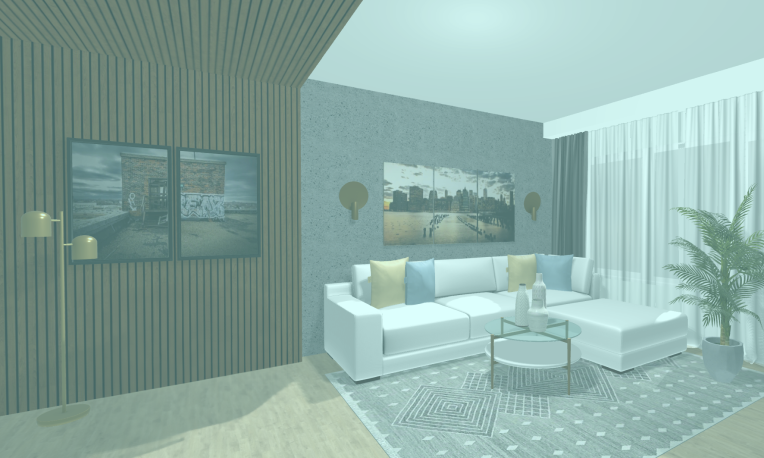Gosh, you certainly didn’t start your interior design business to become an expert in search engine optimization (SEO). But when you consider hiring SEO professionals, all you hear is ca-ching.
It is possible to rank your interior design business’s website for your target keywords—and get tons of free traffic and leads from Google searches.
The good news is, you can it all by yourself (no expensive marketing agency required).
We’re here to help you, hold your hand, and cheer you on.
Even if you decide to hire an agency or freelancer to do SEO for you, this guide will help you cover all your bases and outsource smarter.
What’s in this guide:
- Is SEO the right strategy for your interior design business?
- Should you do basic or advanced SEO?
- 8 steps to do SEO as an interior designer
- How to rank in Yelp and other sites
Is SEO the right strategy for your interior design business?
Before we dive into how to use SEO, we should first address the elephant in the room: Is SEO right for you?
Marketing experts will always declare that their strategy is the best, but the reality is that the marketing strategy that works is the one that you work on.
Real-world relationships and networking still remain essential sources of leads for most interior designers. And many interior designers love marketing themselves on Instagram, because it is an enjoyable way to build a bigger brand.
With that said, SEO is an amazing strategy.
If Google ranks you in the top 3 spots, this communicates to potential clients that you are one of the top 3 designers to consider!
For example, Summer Thornton ranks for “interior designer Chicago.” Wow! 🤩
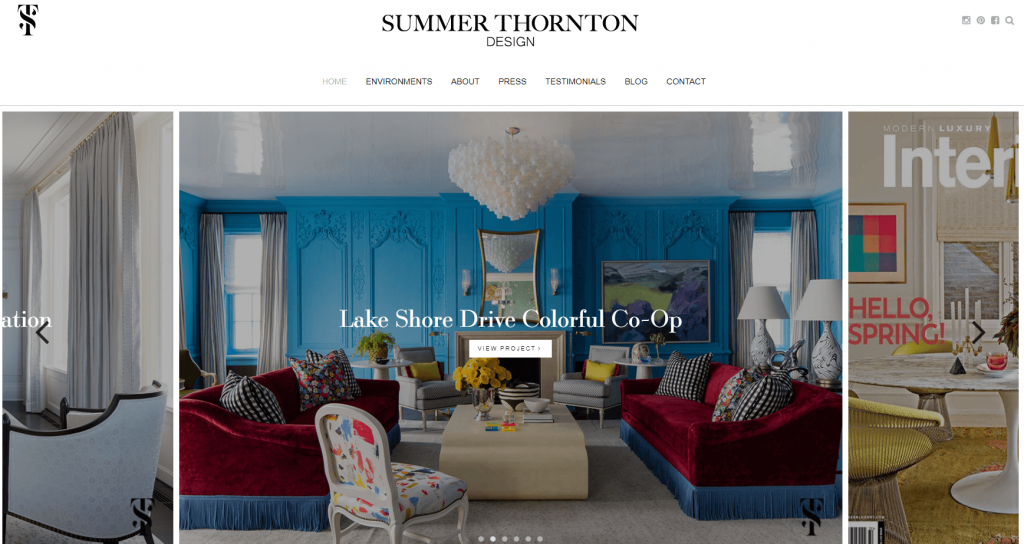
Free SEO tool Ubersuggest estimates that she has over one thousand website visitors per month solely from search engines. (The site likely has additional traffic from other sources.)
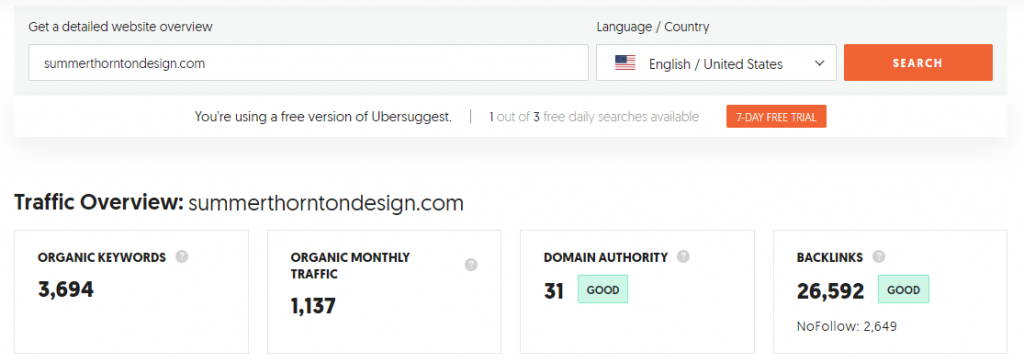
Imagine ranking for your desired title (farmhouse interior designer) or for your city (Austin interior designer). What would that do for your business? It could yield a constant stream of leads in the ready-to-hire phase. That’s because, while Instagram followers might not yet have a need, most people actively searching for interior designers are looking to hire someone. So not only is search traffic somewhat steady, it can also yield higher quality leads.
For those reasons, we believe that nearly every designer should take a stab at SEO.
The real question is how much effort should you put into trying to rank your website in search?
Should you do basic or advanced SEO?
We created an 8-step process to help you do search engine optimization all by yourself.
By breaking these steps into chunks (basic and advanced), you’ll be able to take action sooner and reap the benefits — rather than put off search engine marketing forever.
Designers at every stage of business should do Steps 1 – 3 in our 8 Step process. Only designers with a steady flow of leads from other sources should advance to Steps 4 and beyond.
BASIC:
- Step 1. Research your keywords
- Step 2. Choose where your keywords should go
- Step 3. Optimize your website for your chosen keywords
ADVANCED:
- Step 4. Publish a new blog post monthly
- Step 5. Use digital PR to drive backlinks to your website
- Step 6. Get Google reviews in order to show up in Google Maps
- Step 7: Pay attention to your rankings
- Step 8: Retain your rankings (and never let ‘em go)
Why every designer should do basic SEO (Steps 1 – 3)
Google gives preferential treatment to early birds. While it is possible to kick other websites out of their place and beat them, it is harder to do that than to be one of the first websites that truly matches a keyword. So the earlier you try, the better.
If you have a specific niche, or live in a smaller city, your competitors might be sleeping on the SEO job. This means that you could rank by only doing Steps 1 – 3. You won’t know if you don’t try.
However, for competitive keyphrases (“interior designer New York” comes to mind), SEO is slow to succeed at. It’s never guaranteed that you will rank — ever. So you should do only the basic steps, then keep building up a steady stream of leads with networking and social media. After you’ve got a solid business income, you can move onto advanced SEO strategies.
TIP: Steps 1 – 3 are easiest to do when you’re already revamping your website, but you should do them ASAP even if you weren’t planning on doing any website updates.
How to know if you’re ready for advanced SEO (Steps 4 – 8)
If you already have a steady stream of leads from social media, or from relationships with real estate agents, developers, and other business owners, then SEO is worth your attention. You’ve graduated to the stage of business where your income needs are met, and now it’s about authority and growth.
Ranking in search engines not only brings in traffic, but it also solidifies your authority in your niche or local market. If Google ranks you in the top 3 spots, this communicates to potential clients that you are one of the top 3 designers to consider. This type of authority not only delivers leads who are pre-sold on your expertise, but can also bring in organic media inquiries and collaborations.
TIP: Steps 4 – 8 are designed to help you grow your brand and your audience, so even if you don’t rank you will still get results from your efforts.
8 steps to do SEO as an interior designer
Now that you know how important SEO is, it’s time to go for it. Follow Steps 1 – 3 as soon as possible, and when you’re ready, move on to Steps 4 – 8.
(And if you’re wondering why these steps focus on Google, it’s because it owns 85% of search traffic in the US and 92% in Canada.)
Step 1. Research your keywords
Why this step is important:
Before you optimize your website for target search terms, you first need to research those keywords and make sure that they actually have some recorded search volume.
How to do it:
The first step is to use an SEO software. Ubersuggest is a free SEO tool designed for small businesses. You get 3 searches per day on the free plan.
So, what are the best SEO titles for interior designers? These should usually match your title. So if you offer e-Design services and you call yourself a farmhouse interior designer, then that’s what you’d want to rank for.
As we can see, “farmhouse interior designer” gets about 40 searches per month (in the United States — Ubersuggest only shows national search volumes, not global). That might not seem like a lot. But remember, many of those searchers are actively looking to hire, so just getting a few of them to fill out your lead form could bring in a lot of extra revenue.

However, location-based keyphrases tend to have a lot more search volume than niche ones. As we can see, “interior designer austin” has 1,000 searches per month. So, if you’re choosing between a niche keyphrase and a local one, you should prioritize the local one. (You can choose both. More on that in Step 2.)

Keep in mind that some keyphrases don’t have any recorded volume. If Ubersuggest says there are 0 monthly searches for “tropical interior designer” then it’s probably not worth ranking for. While there might be a few searches per month, the fact that there’s no recorded volume means these searches are few and far between.

Once you’ve double checked that your target keyphrases actually have recorded search volume, you’re read for Step 2.
Step 2. Choose where your keywords should go
Why this step is important:
If your niche or location is likely to change, be careful about optimizing your homepage for your target keyphrases, because if you remove them from your homepage, you will lose all of your rankings.
How to do it:
The vast majority of designers will be better off placing their main target keyphrase in the homepage of their website, because of the way that PR affects SEO (discussed in Step 5).
Contrary to popular belief, this doesn’t have to affect your branding. Take a look at Kerrie Kelly’s website. She doesn’t put her target keyphrase in the hero (top) section of her website, and yet she still ranks for “Sacramento interior designer.”
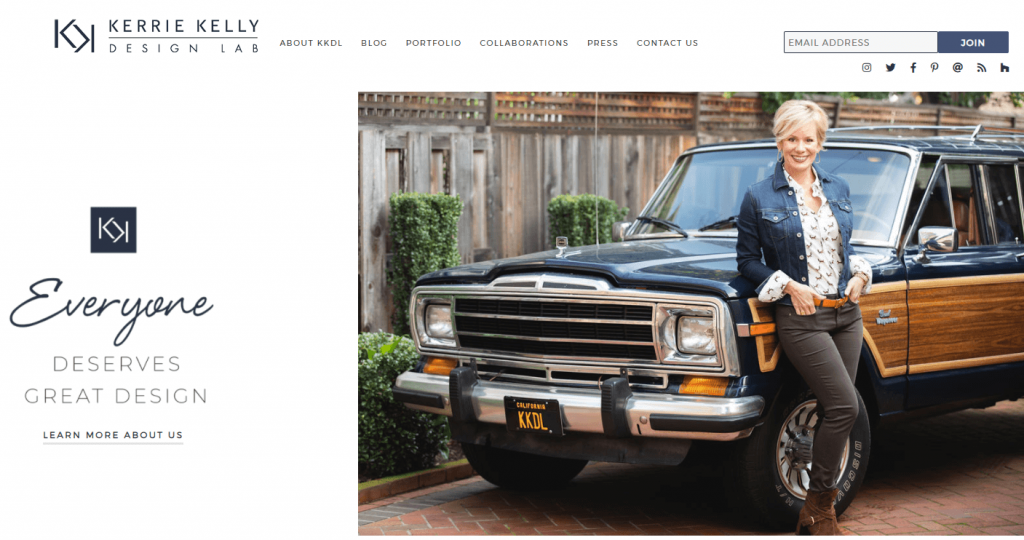
Her target keyphrases are actually in the third section of her website. She includes both “Sacramento” and “Northern California” in the section about her interior design services.
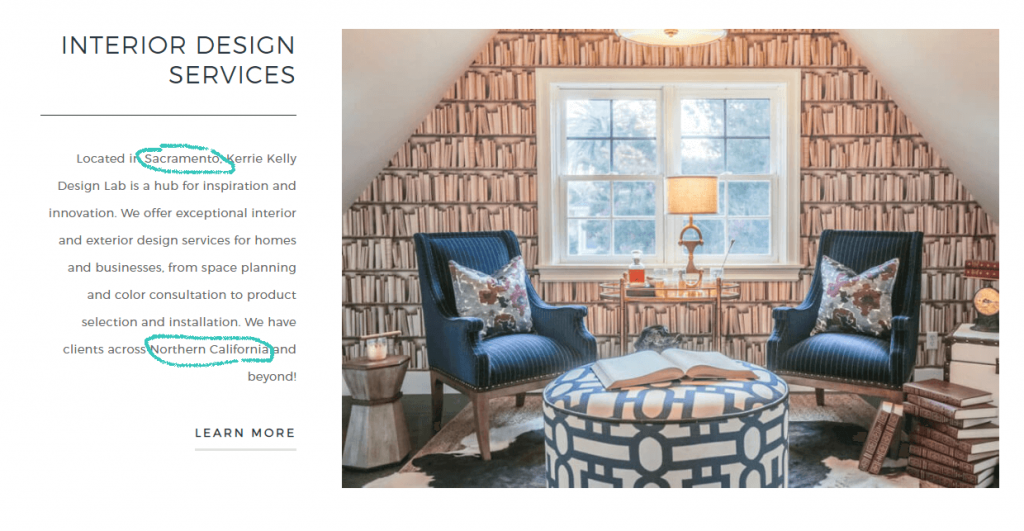
Kerrie Kelly’s website ranks not only because of these keyphrases, but also because of her amazing publicity. (In Step 5, we’ll go over how to use PR to rank in Google search.)
Should your keyphrases go on your homepage? They don’t have to. If you have multiple niches, you could put your target keyphrases on service pages. For example, you could have one page targeting “interior design San Diego” and another targeting “staging San Diego.”
Step 3. Optimize your website for your chosen keywords
Why this step is important:
If you don’t put your target keywords in your website, then Google won’t be able to rank you.
How to do it:
You need to enter your keyphrases on the front end and the back end of your website.
- Front end (what viewers can see) – Add your target keyphrases in headlines and body copy in your site. For example you could have a headline that says “Award-winning Seattle interior designer” and then you could have an “about” section on your homepage that says. “Based in Seattle, Chic Life Labs is an interior design studio for busy professionals who want to love where they live.”
- Back end (website administrator controls) – In the back end, you need to add your keyphrase in the document title, meta description, and target keyphrase fields. Any website builder should have these fields, but sometimes they have a different name, so if you’re not sure, contact customer support. A document title (the title of the page) would be something like “Chic Life Labs | Seattle Interior Designer” and a meta description (140 characters or less) would be “Based in Seattle, Chic Life Labs is an interior design studio for busy professionals who want to love where they live. Explore our services.” For the target keyphrase section, you should enter the 2-4 word keyphrase you’re going for, such as “Seattle Interior Designer.”
Luckily, there are plugins that make all of this even simpler.
Rank Math SEO is a free plugin for WordPress websites that makes it easy to add the target keyphrases in the back end of your website. It also gives you a checklist of SEO actions to do, and if these aren’t done yet, you’ll see a red X next to them.
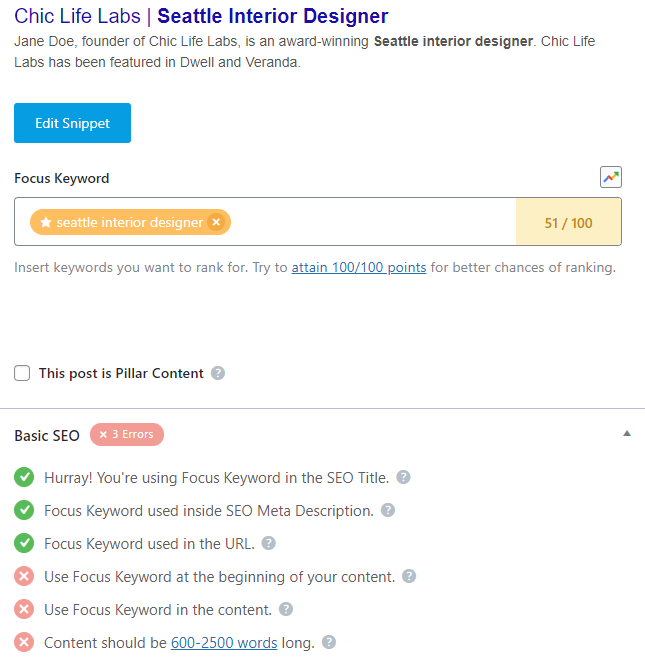
If you are SEO-optimzing a new page (not your homepage), then make sure that the URL of that page matches your target keyphrase exactly. For example, a landing page URL might be chiclifelab.com/seattle-interior-designer.
Step 4. Publish a new blog post monthly
Why this step is important:
Blogging shows Google that your business is active while also building up topical authority. What is topical authority? Simply put, Google is more likely to rank websites that have lots of content around a certain topic, rather than a website that put up a single SEO-optimized landing page and then didn’t write anything else. It makes sense when you think about it!
So, even if your individual blog posts don’t rank for their target keyphrases, as long as they are relevant to your business, these blog posts can still be useful in ranking your homepage, services pages, or location pages.
How to do it:
Even though your individual blog posts don’t have to rank in order to have an impact on your SEO, it’s still wise to SEO-optimize most of your blog posts. Seek to find a keyphrase for 70-80% of your blog posts.
For example, if you want to write about a specific trend, such as jewel tones, then you could hop over to Ubersuggest and see if there’s any recorded search volume for that idea. “Jewel tone interior” has 140 searches per month.
Put the target keyphrase in the title of the blog, meta description, URL, in a subheading, and in a couple of paragraphs (but don’t overstuff it).
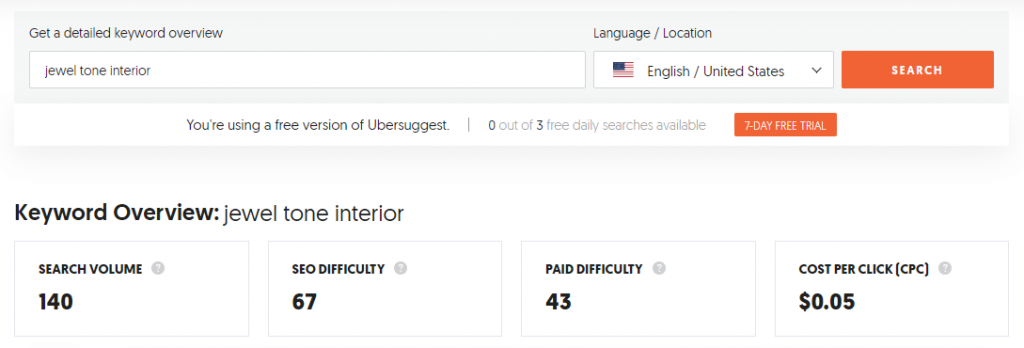
By doing your keyphrase research, you give yourself a shot at ranking in even more Google searches, which could lead to projects and media inquiries.
But, if you get a fun idea that has nothing to do with SEO, go for it. Your blog is a place to build your topical authority and your brand. In this example, a team of interior designers share summer inspiration.
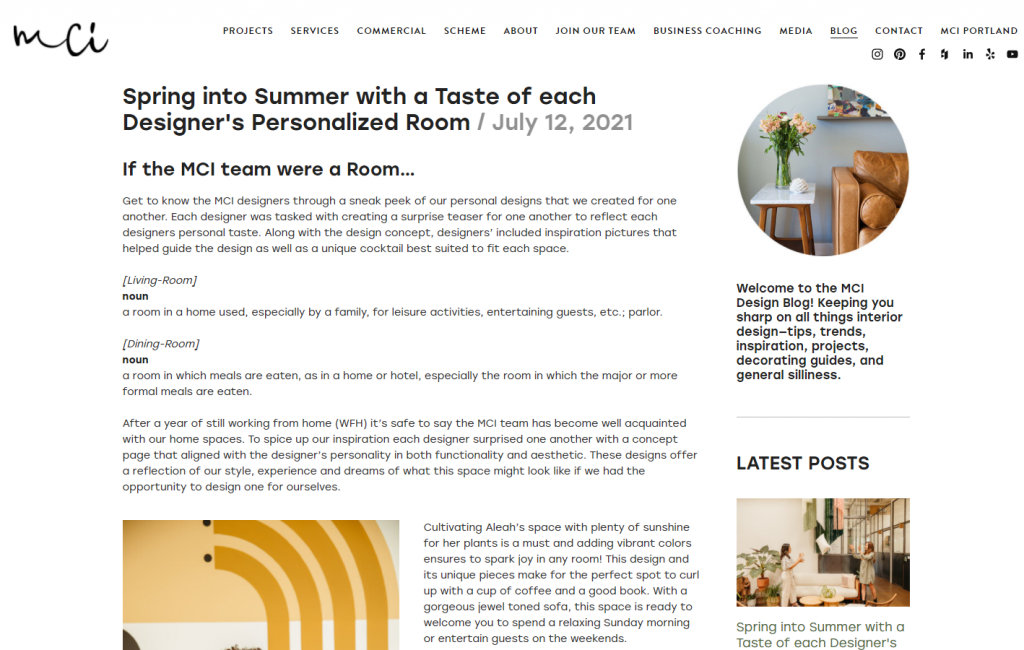
Step 5. Use digital PR to drive backlinks to your website
Why this step is important:
Wait what?! You’re telling me PR impacts SEO?!
Yup, that’s exactly what we’re telling you.
- (SEO) What you say = Putting keyphrases in the front end and back end of your website is the same thing as you telling Google what you want to rank for.
- (PR) What other people say = Digital PR in the form of media features, guest blogs, podcast interviews, and conference speaking engagements all act as ways for other websites to validate your authority and offer a seal of approval in Google’s eyes.
To rank for competitive keyphrases, you need both SEO and PR.
You need to tell Google what you want to rank for, and you need trusted websites linking to you. When another website links to your website, it’s called a “backlink.” Quality backlinks tell Google that you’re a true expert.
How to do it:
There are so many ways to get backlinks from digital PR. And the good news is that this also builds your brand and drives traffic and leads!
Below, we’ll take a look at some of the different options.
You could get featured in a round-up like this. It’s an article from The LowDown showing their top interior designer picks from every US state.
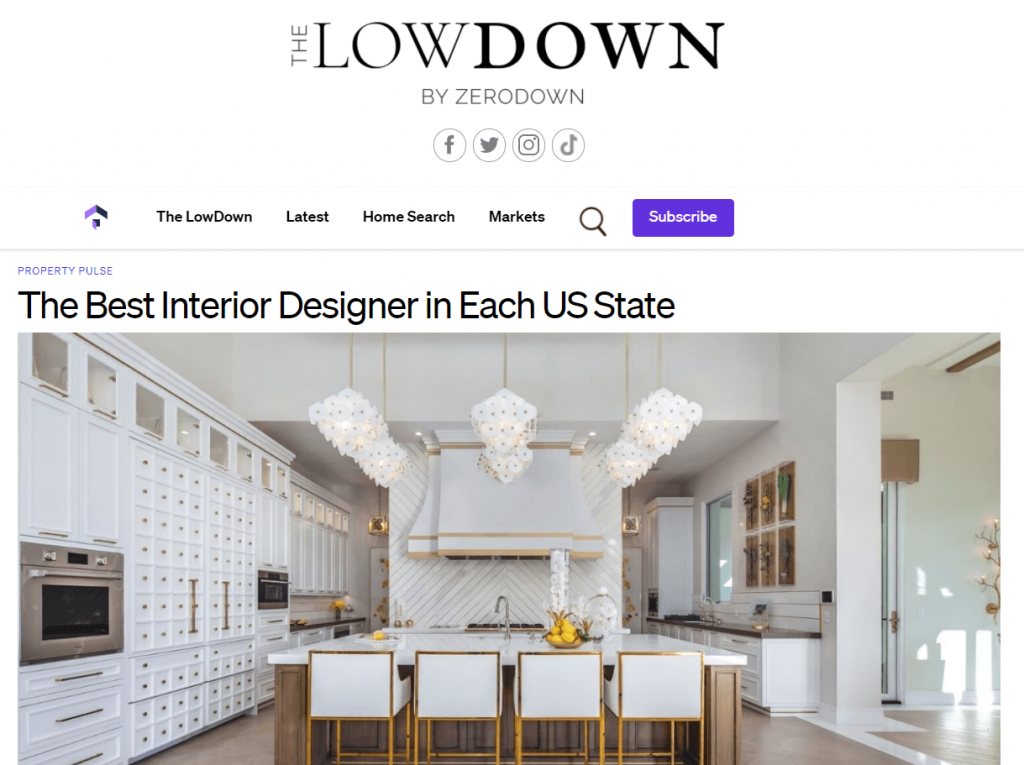
Anchor text is a fancy schmancy way to describe the word or phrase that your site is linked from. Here are two examples of anchor text from that article:
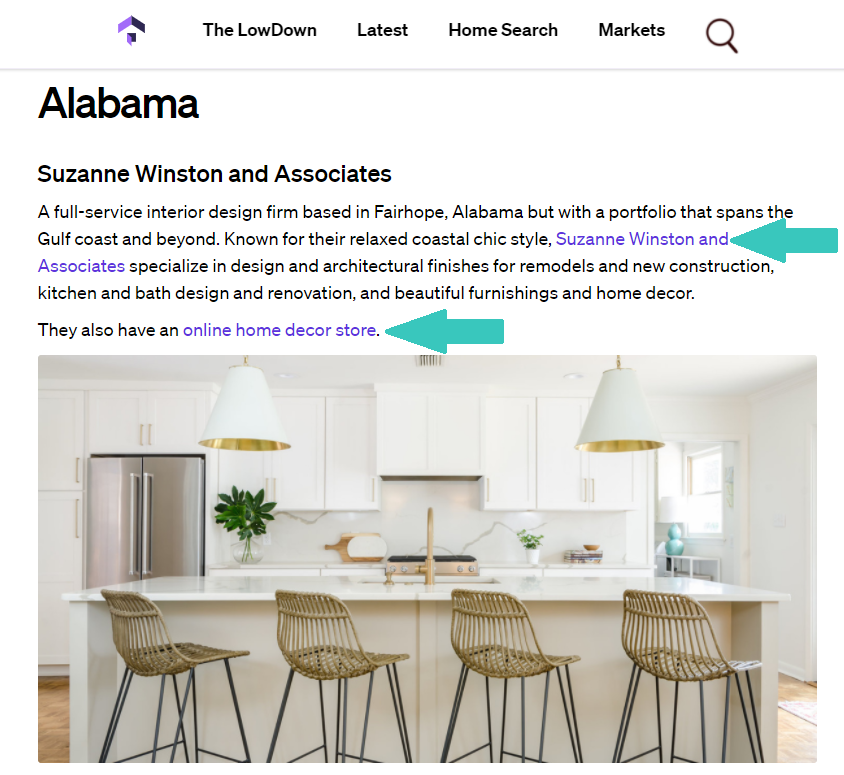
For most quotes and features, you will get linked to from the name of your business. So if your business is Chic Life Lab, then that is most likely the phrase that the journalist will use to link to you.
Those types of links are great, but as you go along, you should also try to build backlinks with even more specific anchor text. For example, if you want to rank for “Seattle interior designer,” then you could ask a podcast host to link to your website with that anchor text. Or, if you’re writing a guest post, you could link to your website in the body of the post or from your guest author bio.
The most important thing is to get some high quality backlinks, regardless of the anchor text. So if you’re having a hard time getting other websites to link to you from “Seattle interior designer” instead of “Chic Life Lab,” don’t worry about it too much.
So how do you get these media features?
You could use Help a Reporter, a place journalists go to find sources. Sign up for the daily emails and scan through them (or have your assistant scan through them) to find relevant journalist queries and answer them with a thoughtful response.
For example, a journalist might write “Looking for Interior Designers’ Top Tips for Elegant Holiday Decor.” Journalists receive lots of responses, so think outside of the box before writing your answer. In your email response, make sure you put your unique tip or idea in the subject line of your email so it stands out. If you’re selected, the journalist will almost always link back to your website when quoting you.

Here’s an example of an interior designer being featured in a local magazine. This is great because you get the local press, plus you get a quality backlink showing Google that you are a local interior designer in Sonoma.
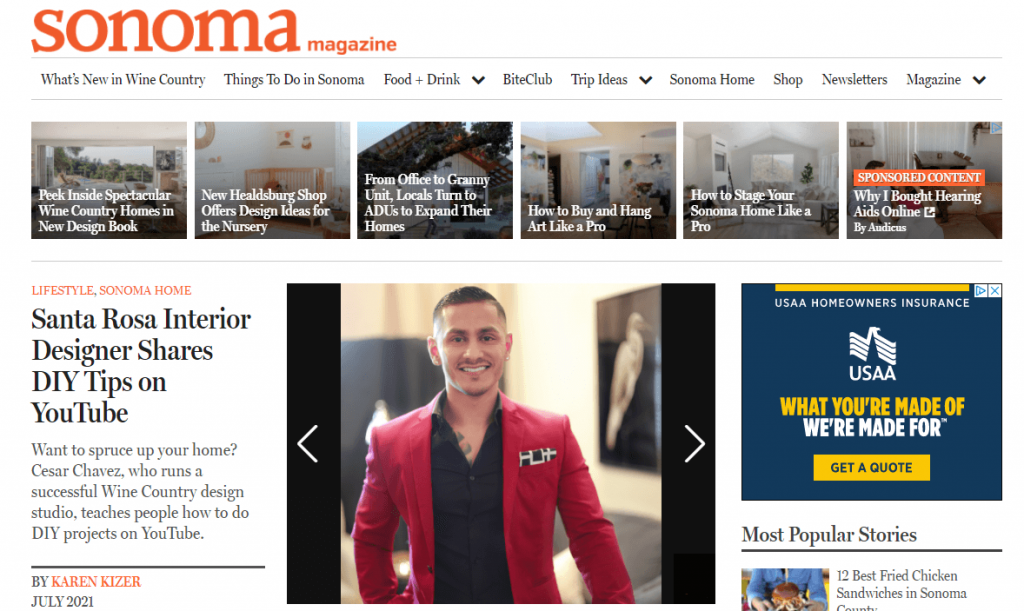
You don’t have to wait for this sort of press to come to you.
You could reach out to local journalists directly, and also journalists who write for design and lifestyle magazines. Keep in mind that it’s easier to get featured in digital media versus print media.
Every media company will have a masthead with contact information:
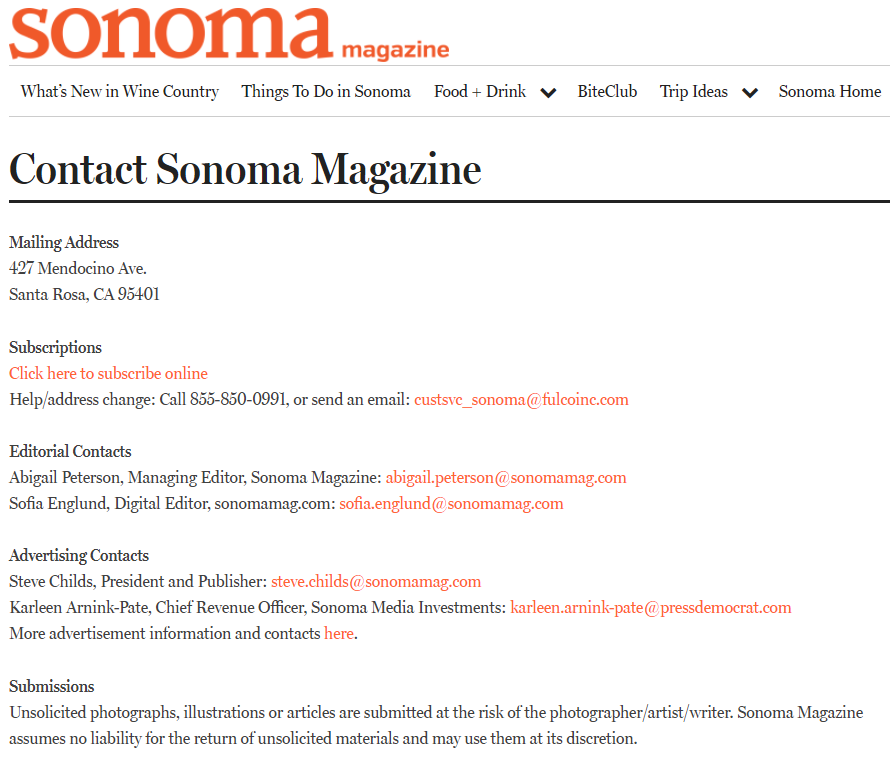
If you find a writer on the site who already covers businesses like yours and who would be perfect to feature you, but you don’t see them in the masthead, you could use a tool like Hunter.io to find their email address for free.
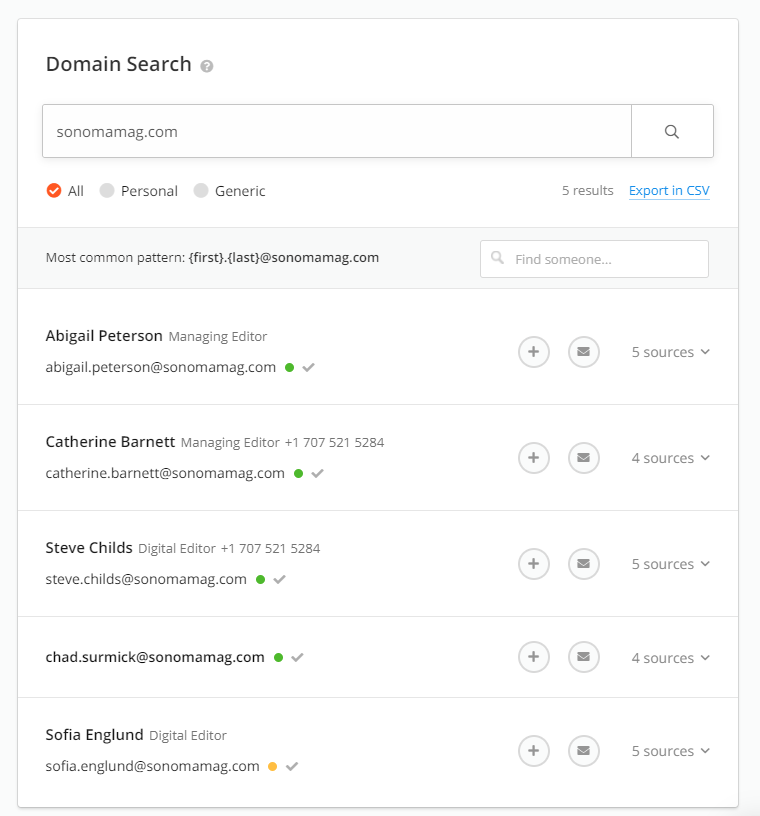
Then, send them an email pitch. Here’s an example:
Subject line: Pitch – Seattle area designer on locally inspired living spaces
Hi Catherine,
As a Seattle-based interior designer, clients often want spaces that give a nod to our local history and environment without being too kitschy or touristy. I’ve created dozens of living spaces for local clients that elevate the Seattle style.
I’d be happy to share my tips for DIY homeowners, along with plenty of photos for inspiration.
I have 10 years of design experience in Seattle and surrounding areas, and my business has previously been featured in The Spruce and House Beautiful.
Does this story appeal to you?
All the best,
[Your signature]
Make sure you always have a unique angle. Whether that’s to highlight a recent success, share unique tips, or appeal to a local audience. Include that unique angle both in the subject line and body of your email.
A short 1 – 2 sentence description of yourself shows the journalist that you’re an expert on the topic. If you don’t have previous features, then simply talk about your design experience, how many years you’ve been in business, and the types of clients you serve.
You could also search #journorequests to find relevant queries.
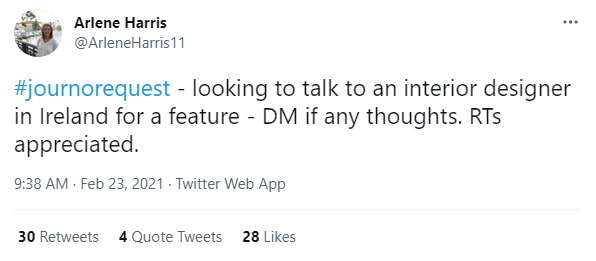
Typically, you can only DM someone if you are following each other, so if you want to share your answer, then simply comment on the tweet, with something like, “I’m an interior designer based in Dublin, Ireland with 10 years of experience. My business has previously been featured in The Spruce and House Beautiful. I’d love to help!”
Podcasts are another way to build quality backlinks to your website. You could use a tool like PodBooker or Postaga to make it easier to find and pitch podcasts.

Make sure to do some competitive research too. Find out what podcasts other designers have been featured on by searching for designers names that you admire along with the word “podcast” in Google.
Aim to apply to both local spotlights and guide podcasts and design-specific podcasts. When pitching design podcasts, make sure to include a unique angle that you would talk about on the show, like a specific trend or tip. But when pitching a local podcast that features business owners, you can simply pitch the fact that you are a local designer, and also mention a few different ideas for what you could talk about on the show.
If you are trying to rank a services page (not your homepage), you should try to get backlinks to that page too, not just your homepage. You can do this by writing guest blogs and linking to that page in the text, or by asking a podcast host to link to that page from the show notes instead.
Step 6. Get Google reviews in order to show up in Google Maps
Why this step is important:
Just like backlinks, Google reviews are another thing that Google uses to determine if your site is worth ranking higher than others. Google reviews are important because they increase your chances of showing up in Google Maps. For local-intent keyphrases, Maps results are at the top of the page. Google reviews are especially important for designers wanting to rank for location-based keyphrases like “interior designer Seattle” but they can also help you rank for niche-based keyphrases like “Victorian interior designer” because Google will show nearby interior design businesses based on the searcher’s location.
You don’t have to have tons of reviews to show up in Google Maps, but lots of reviews make it more likely that you will show up there.
How to do it:
If you want your business at the top of search results for local queries, then you need to get as many positive online reviews as possible.
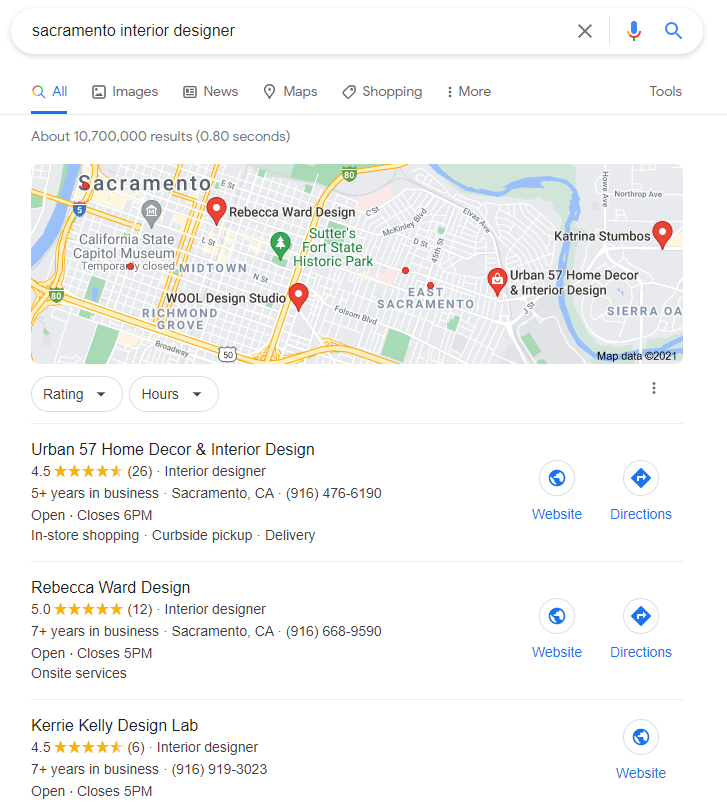
It’s worth noting that searchers don’t even need to type their city for Google to show Maps. If you search “interior designer” (without adding your city name) on your computer or phone, Google will still show local results, as long as you’re signed in to your Gmail account, or Google has permission to know your location.
This is one of the easiest parts of SEO. Just ask your clients for reviews! Make sure to ask clients who you know were satisfied with your services.
Here’s an email template you could modify:
Subject line: Quick request for a Google review (it matters a lot)
Hi Claire,
I loved working with you, and am so happy your dream living room came to life!
I have one quick favor to ask: would you write me a Google review?
This helps other potential clients trust me, and it has a big impact on getting my website to rank in Google search results — which is a goal of mine.
If you’re willing, here’s the link to leave me a review: [your Google My Business page link]
Thanks so much! And feel free to let me know of any questions.
[Your signature]
Step 7: Pay attention to your rankings
Why this step is important:
You’ll want to find out if you’ve actually ranked for anything yet. If you are, this will change your approach, which we explore below and in Step 8.
How to do it:
Here’s how to find out if you are ranking for anything. Head over to Ubersuggest and type in your website domain name, such as summerthorntondesign.com.
Then, scroll down to the “SEO Keywords” section to find out what you’re ranking for and in what position. Keep in mind that Google is an algorithm, and rankings and positions can change daily, so Ubersuggest isn’t always 100% accurate in terms of the exact position.
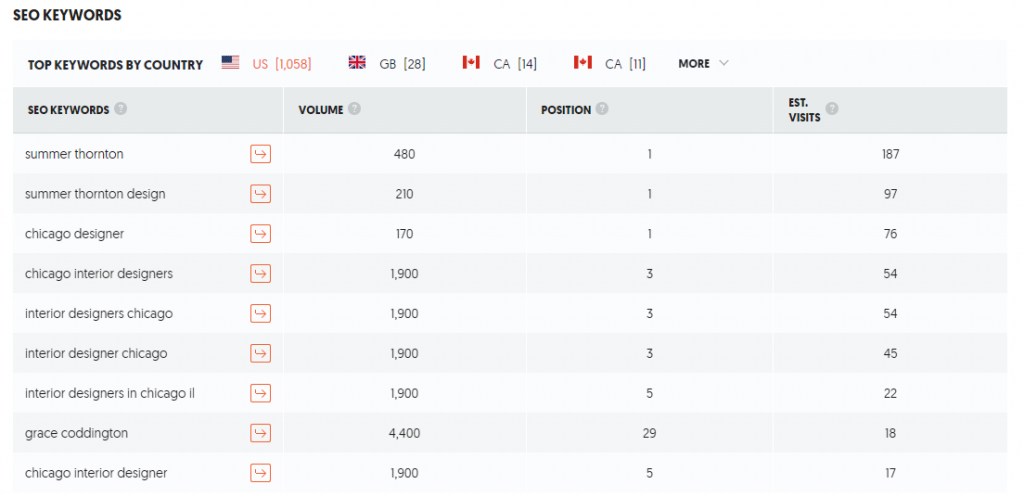
You can also manually do a Google search and see if you can spot your website on Page 1.
If you are ranking for your target search terms on Page 1 of Google, congratulations! You can move on to Step 8.
If you haven’t ranked yet — or if you’re ranking blog posts but not your homepage or services page yet — you’ll want to keep working on getting backlinks (Step 5) and Google reviews (Step 6). You might also double check that your front end and back end keyphrase targeting was done correctly (Step 3).
Step 8: Retain your rankings (and never let ‘em go)
Why this step is important:
Just because you rank for your ideal search now, doesn’t mean you will forever. The good news is that Google doesn’t want extreme volatility in their search ranking pages. It’s not a good user experience for things to be changing all the time. People use Google to find things, so wild and constant fluctuations would be annoying. That means that once you rank, Google is happy to keep you there as long as you do your part to stay.
How to do it:
At this point in the game, you’re now in defense mode.
Essentially, you’ll want to keep doing all of the steps above, you can just do them less frequently. So, if you’ve been blogging monthly to build up your topical authority, you can now blog quarterly. If you’ve been strategically building two backlinks each month to your website, you can switch to two backlinks each quarter.
If SEO becomes a key driver of business (if clients say that’s how they found you), then you might want to upgrade to a more advanced SEO tool. Leave Ubersuggest behind and sign up for Ahrefs instead.
You can use the “Movements” feature to track your shifting and lost rankings.
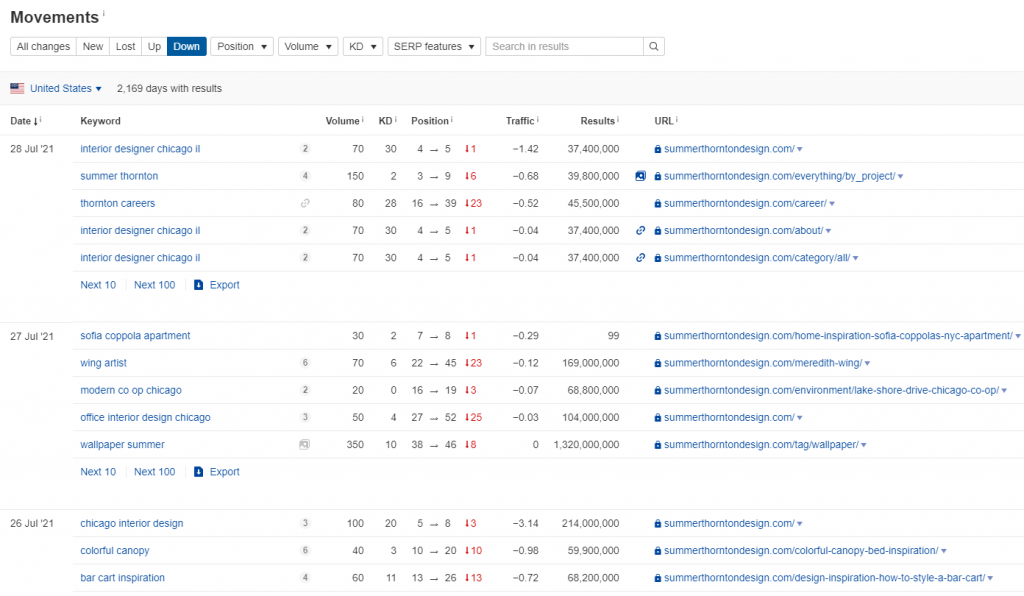
Some of the decreasing rankings will be irrelevant terms that you are on page 10 for, but some might be your most valued keyphrase (like Seattle interior designer).
If you don’t want to pay for software, you can also just manually search your website every month for your top searches and see where your website is ranking.
If you find that you’re losing important rankings, then you should update your home page and services page with some fresh text and images, publish a new blog post related to your target keyphrase, and drive a couple backlinks to your website.
How to rank in Yelp and other sites
Listings and directories like Yelp and Thumbtack can be a great source of business for interior designers. Unfortunately, these sorts of websites rank for many interior designer keyphrases, meaning there’s even less space on page 1 of Google results for actual small business owners’ websites.
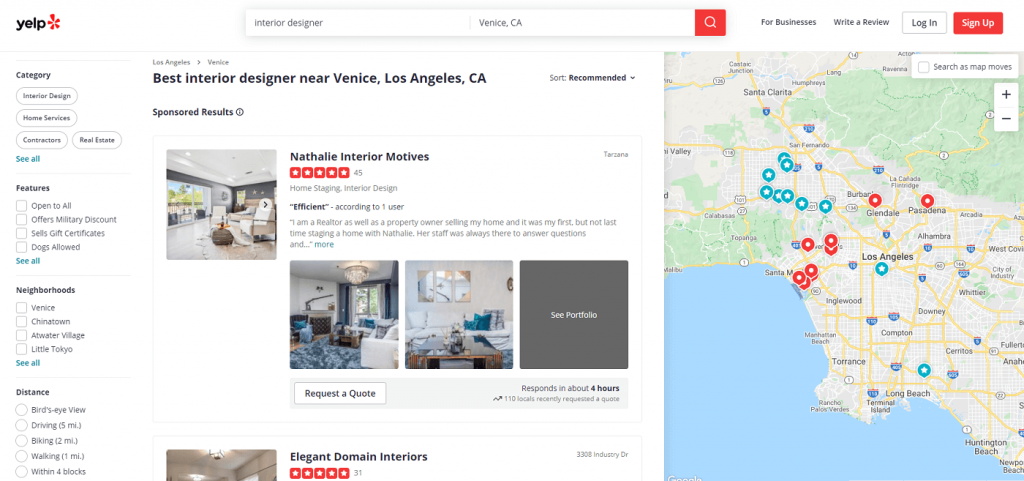
If you live in a smaller town, it’ll be easier to get featured on Google directly, but if you live in a big city, you might have better results trying to rank in one of these directory websites.
The process is similar to what’s described above, but much simpler. You need to create an accurate profile, and make sure your location is in your description. The more positive reviews you have and the more complete your profile, the more likely you are to rank in one of these directories.
If you want to get reviews on these websites and on Google, you could switch off what you ask clients to do. So if you ask one client to review you on Google, ask the next one to review you on Yelp. For your most satisfied and raving clients, you could ask them to review you on multiple sites.
While Yelp and Thumbtack are popular across North America, there might be city or county directory sites that are relevant for you too, so do your research and find out what else is available. Many smaller websites only require your business information, and you don’t have to try to get reviews or continually update your portfolio.
You can do this
Yes, SEO is a bit technical. But no, it’s not impossible. In fact, many designers don’t rank in Google simply because they count themselves out of the game before they even try.
But showing up in Google is amazing. It offers free, targeted traffic. Plus, it portrays you as an authority.
Follow these steps, stay committed, and you’ll be getting more leads than you can handle. And not just any leads—ones who are actively looking for a designer and who see YOU as the expert.
Check out DesignFiles for easy design tools, an active community of interior designers, and lots of helpful content.
